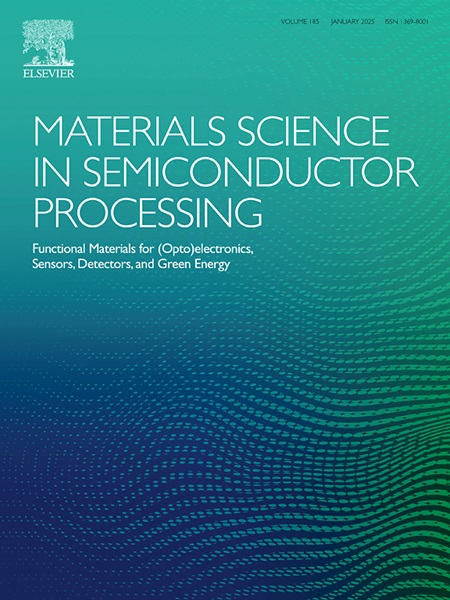Theoretical investigation of structural and elastic properties of Ag2SiS3 chalcogenide
IF 4.2
3区 工程技术
Q2 ENGINEERING, ELECTRICAL & ELECTRONIC
引用次数: 0
Abstract
In this work, density functional theory was used to study the structural and elastic properties, cohesion energy, and formation energy of the Ag2SiS3 ternary chalcogenide compound. The calculations were performed using the norm-conserving and ultra-soft charge pseudo-potential in GGA and LDA approximations. The negativity of the measured value of cohesion and formation energy indicates the stability of the compound. At the E-Γ point, an indirect band gap with the sizes LDA + US = 1.17eV, GGA + US = 1.29 eV, and GGA + NC = 1.24 eV was obtained. Important characteristics of the elastic properties were studied, including anisotropy, bulk B, Young's modulus E, shear modulus G, minimum thermal conductivity (kmin), Cauchy pressure (PC), Grüneisen parameter (γ), Poisson's ratio (ʋ), Debye temperature (θD), and melting temperature Tmelt. From examining PC, G/B, and ʋ, we found that the composition is ductile, and there are also ionic bonds between atoms. V was checked in (100), (010), and (001) directions; the value of V was different in these directions (Vl was greater than Vt in all directions), which indicates sound anisotropy. The θD value in this combination, LDA + US = 203.6 K, GGA + US = 217.54 K, and GGA-NC = 191.89 K, and the Tmelt(±300K) value in LDA + US = 701.445 K, GGA + US = 644.85 K, and GGA-NC = 584.25 K, were obtained. The values obtained of Kmin in the Clarke (Cahill) model have various amounts in different directions, and these values indicate the anisotropy of Kmin. The values of Kmin in the direction 100 in the Clark model are GGA-NC = 0.036 (W/mK), GGA-US = 0.042, and LDA-US = 0.043. After examining the properties of the Ag2SiS3 compound, we found that it is ductile, resistant, with good machinability, completely anisotropic, has strong atomic bonds, and is particularly stable. Given its properties, it is perfectly suitable for manufacturing and use in industry.
硫化物Ag2SiS3结构和弹性性能的理论研究
本文采用密度泛函理论研究了Ag2SiS3三元硫系化合物的结构、弹性、内聚能和形成能。利用GGA和LDA近似中的规范守恒和超软电荷赝势进行了计算。聚能和形成能的测量值呈负向,表明化合物的稳定性。在E-Γ点处,得到了LDA + US = 1.17eV、GGA + US = 1.29 eV和GGA + NC = 1.24 eV的间接带隙。研究了各向异性、体积B、杨氏模量E、剪切模量G、最小导热系数kmin、柯西压力(PC)、gr neisen参数(γ)、泊松比(k)、Debye温度(θD)和熔融温度Tmelt等弹性性能的重要特征。通过对PC、G/B、和k的检测,我们发现其成分具有延展性,并且原子间还存在离子键。在(100)、(010)和(001)方向上检查V;各方向V值不同(各方向Vl均大于Vt),说明声音各向异性。该组合的θD值为LDA + US = 203.6 K, GGA + US = 217.54 K, GGA- nc = 191.89 K, Tmelt(±300K)值为LDA + US = 701.445 K, GGA + US = 644.85 K, GGA- nc = 584.25 K。Clarke (Cahill)模型得到的Kmin值在不同方向上有不同的量,这些值表明了Kmin的各向异性。Clark模型中100方向的Kmin值为GGA-NC = 0.036 (W/mK), GGA-US = 0.042, LDA-US = 0.043。在对Ag2SiS3化合物的性能进行检测后,我们发现它具有延展性,耐腐蚀性,良好的切削性,完全各向异性,具有强原子键,并且特别稳定。鉴于其性能,它非常适合于制造和工业使用。
本文章由计算机程序翻译,如有差异,请以英文原文为准。
求助全文
约1分钟内获得全文
求助全文
来源期刊

Materials Science in Semiconductor Processing
工程技术-材料科学:综合
CiteScore
8.00
自引率
4.90%
发文量
780
审稿时长
42 days
期刊介绍:
Materials Science in Semiconductor Processing provides a unique forum for the discussion of novel processing, applications and theoretical studies of functional materials and devices for (opto)electronics, sensors, detectors, biotechnology and green energy.
Each issue will aim to provide a snapshot of current insights, new achievements, breakthroughs and future trends in such diverse fields as microelectronics, energy conversion and storage, communications, biotechnology, (photo)catalysis, nano- and thin-film technology, hybrid and composite materials, chemical processing, vapor-phase deposition, device fabrication, and modelling, which are the backbone of advanced semiconductor processing and applications.
Coverage will include: advanced lithography for submicron devices; etching and related topics; ion implantation; damage evolution and related issues; plasma and thermal CVD; rapid thermal processing; advanced metallization and interconnect schemes; thin dielectric layers, oxidation; sol-gel processing; chemical bath and (electro)chemical deposition; compound semiconductor processing; new non-oxide materials and their applications; (macro)molecular and hybrid materials; molecular dynamics, ab-initio methods, Monte Carlo, etc.; new materials and processes for discrete and integrated circuits; magnetic materials and spintronics; heterostructures and quantum devices; engineering of the electrical and optical properties of semiconductors; crystal growth mechanisms; reliability, defect density, intrinsic impurities and defects.
 求助内容:
求助内容: 应助结果提醒方式:
应助结果提醒方式:


